Carpet Beetles
What Are Australian Carpet Beetles and How To Get Rid of Them

Best Ways to Detect & Treat Australian Carpet Beetles
Carpet beetles, if you've ever heard of them, are tiny insects that cause many problems when they enter your home and start attacking your carpets, rugs, clothes, and furniture, creating a nuisance.
If you happen to come about a carpet beetle in your home, the chances are pretty high that there are even more living in your home. This is because they are extremely small (about the size of a pin head) and by the time you notice the damage they have caused, they have more than likely spread to other areas.
So let's look at what these insects really are, other things you should know, and how to eliminate them effectively.
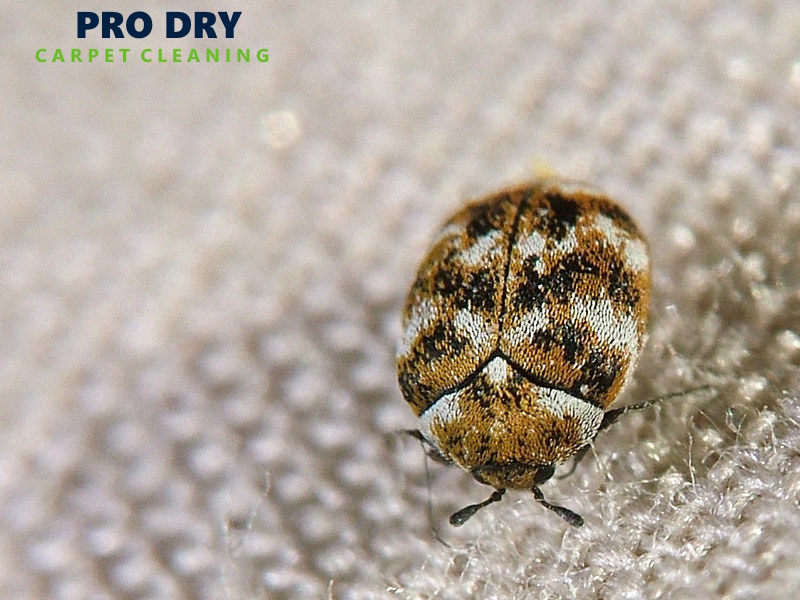
What Are Carpet Beetles?
Carpet beetles are a type of small, oval-shaped beetle that belongs to the family Dermestidae. They are common household pests in Australia and can cause damage to carpets, upholstery, clothing, and other fabric items.
There are several species of carpet beetles that are found in Australia, including the Varied Carpet Beetle (Anthrenus verbasci), the Black Carpet Beetle (Attagenus unicolour), and the Furniture Carpet Beetle (Anthrenus flavipes).
| Genus: | Anthrenocerus |
| Species: | Australis |
| Family: | Dermestidae |
| Subfamily: | Megatominae |
| Order: | Coleoptera |
| Class: | Insecta |
| Phylum: | Arthropoda |
Distribution: You can find different types of carpet beetles spread out across all areas in Australia.
Habitat: The Australian carpet beetle lives in woodlands, forests and urban areas. Carpet beetles can be found in rugs and carpets, as their name suggests, but they also like living in dark areas and away from direct sunlight. So if you suspect your home to have a carpet beetle infestation, you should check under the skirting of your house, the closets and dressers, behind baseboards, under upholstery, and pantries.
You can also find them in places with a lot of dust and pet fur, like under heavy furniture, since they also feed on these.
Diet: The Australian carpet beetle can feed on various items inside a home, such as clothes, rugs, furs, furniture, and carpets. They also feed on dead animal skin, pet hair, pollen and flowers.
Other Behaviours: The larvae of the carpet beetle are hairy, which can cause rashes and allergic reactions varying in severity depending on how long the exposure to the insect was.
Adaptations: Before introducing household items to these carpet beetles, their diet mostly consisted of dried animal skins, protein, and spider webs.
Control Methods: Adult carpet beetles can fly, so they can easily enter homes through open doors and windows and start the infestation. The best way to eliminate them is to vacuum regularly and undertake the services of professional carpet cleaning with superior expertise or pest control.
From the Dermestidae family of beetles, the Australian carpet beetles are known to infest the homes of many unaware people and destroy household items, mainly consisting of fabrics, rugs, carpets, and clothes.
Although harmless, these beetles have the potential to cause a lot of damage to the integrity of your house by their mere presence. As the name suggests, these carpet beetles thrive in places like your carpets at home since they feed on natural fibres and fabric.
One of the significant aspects of this pest is that adult carpet beetles are less likely to cause any nuisance indoors since they feed on plants and pollen.
However, the larvae of this beetle, which are significantly larger than their adult counterpart, are the ones who feed on organic materials inside the house, such as fabrics and animal products.
They hide in the dark and come out to feast at night, so it is very difficult to spot and get rid of them until it is too late.
What Do Australian Carpet Beetles Look Like?
The varied carpet beetle is the most common species in Australia and is often found in homes and other buildings. It is approximately 3-4mm in length and has a mottled appearance, with scales of yellow, white, and black on its body.
The black carpet beetle is larger, measuring up to 5mm in length, and is entirely black. It is commonly found in stored products such as grain, cereal, and pet food, as well as in animal carcasses.
The furniture carpet beetle is similar in appearance to the varied carpet beetle but is less common. It is typically found in upholstered furniture and can cause significant damage to fabrics. They are around 1mm to 3mm in length.
You'll find carpet beetles in dark yellow, brown, and white, with abstract patterns on their shells. These are not to be confused with the carpet moth, a pest that does similar damage but is something different.
In older carpet beetles, you might notice that the stripes of colour or the pattern on their shells start wearing off, and they carry a more solid colour, like full brown or black.
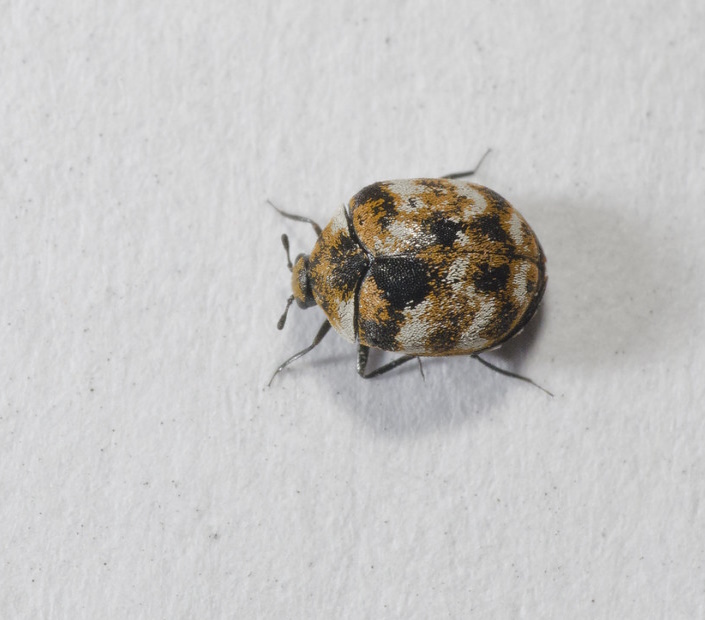
What Do Carpet Beetle Eggs and Larvae Look Like?
The larvae are sometimes called woolly bears and are surprisingly much larger than their adult beetle counterpart.
They stand a good 2.5 cm long and have a solid colour that can carry from light brown to darker shades or even black. If you look closely, you'll find that the larvae have dark hair.
The eggs are entirely different from their adult colours. The larvae are usually cream or white and are 1mm long or smaller. Like many insect breeds, the carpet beetles also lay about a hundred eggs at once, taking only about ten days to a month to hatch.
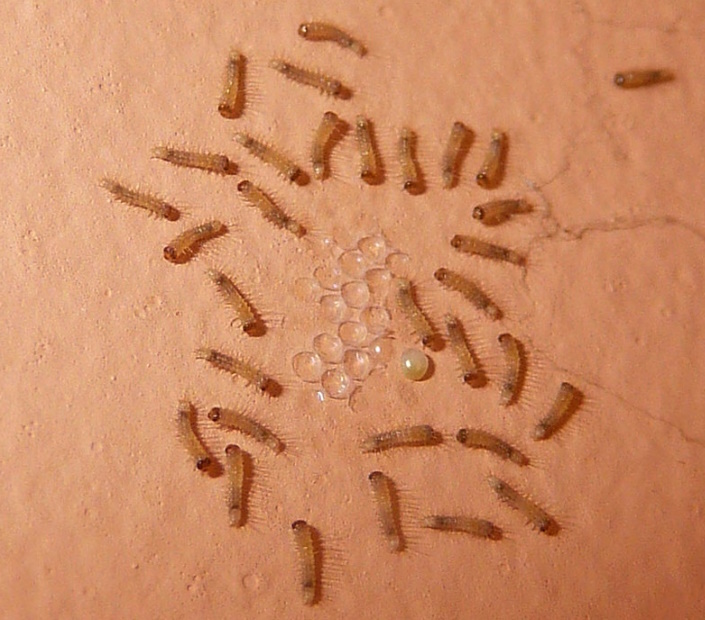
What Causes Carpet Beetles?
Carpet beetles feed on a variety of organic materials, including wool, silk, fur, feathers, and animal skins. They are attracted to items that are high in protein and may also feed on dead insects or other organic matter, so the choice of carpet in your premises will actually influence this.
It's easy for these beetles to start a breeding ground in your home. One of the main reasons is their diet, which consists of animal products, dead skin on surfaces, and fibres, making it easy for them to thrive in any home that is empty, unoccupied, or unclean.
Still, you might convince yourself that your home has not fallen victim to these treacherous insects, but if you find holes in your furniture that you did not put or in your clothes, it's a sign that the carpet beetle infestation has started.
So the next time you think about pushing your spring cleaning days to the following weekend, you better thoroughly check your home before you put it off. One of the places where you might find possible breeding areas for these carpet beetles is in dark spaces away from direct sunlight.
Even if you maintain a clean home, you might still suffer from such an invasion if you are a frequent visitor or buyer of garage and yard sales or frequenting the flea market. These beetles can lay their eggs on clothing, furniture, and rugs, which can start a full-on infestation when brought inside your home.
What's The Life Cycle of A Carpet Beetle?
The life cycle of Australian carpet beetles varies depending on the species, but it consists of four stages: egg, larva, pupa, and adult. Here is a general overview of the life cycle of Australian carpet beetles:
Egg Stage: Female carpet beetles lay their eggs on or near the food source, which is typically a natural fibre material like wool, silk, or cotton. The female could lay 40 to 90 white eggs that can hatch within 8 to 15 days.
Larva Stage: The larva stage is the most damaging stage for carpet beetles as they feed voraciously on the natural fibre material they inhabit. The larval stage lasts 60 days to over a year, depending on the species and environmental conditions. During this stage, the larvae will be moulting several times and avoiding light.
Pupa Stage: After the larval stage, the carpet beetle enters the pupa stage, during which it transforms into an adult beetle. The pupa stage lasts for around two to three weeks.
Adult Stage: After emerging from the pupa, the carpet beetle becomes an adult. The adult stage will typically only last a few weeks, depending on the species and environmental conditions. Adult carpet beetles feed on nectar and pollen and do not cause damage to natural fibre materials.
The entire life cycle of Australian carpet beetles can take several months to a year, depending on the species and environmental conditions. It's important to note that the larvae of carpet beetles are the most destructive stage and can cause significant damage to natural fibre materials like wool, silk, and cotton.
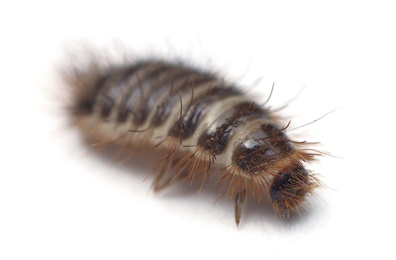
Carpet Beetle Larvae - "Wooley Bear"
Signs of Carpet Beetles
Carpet beetle infestations can be difficult to detect, as the adult beetles are small and often hide in dark, hard-to-reach places. Here are some signs of carpet beetles for you to look out for:
Finding Holes In Carpets, Fabrics, And Clothes:
One of the sure signs that you're housing carpet beetles is if you find holes in your clothes and other fabrics like rugs and carpets. Unlike moths, they tend to feed in clusters, so instead of big holes in your clothes and fabrics, you will find a lot of tiny holes.
They feed on these items to survive, so if you find small holes that are consistently several, you better start checking around your house for these little destructive beetles.
Remember that damage inside the house in your rugs and clothes is usually the job of the larvae and not an adult carpet beetle. This is because adults tend live on pollen and plants, so you might find them outside your house but rarely inside.
On the other hand, the beetle larvae feed on fabric, pet hair, and other household items, so when you start hunting for these bugs, it's a good idea to consider what the larvae look like.
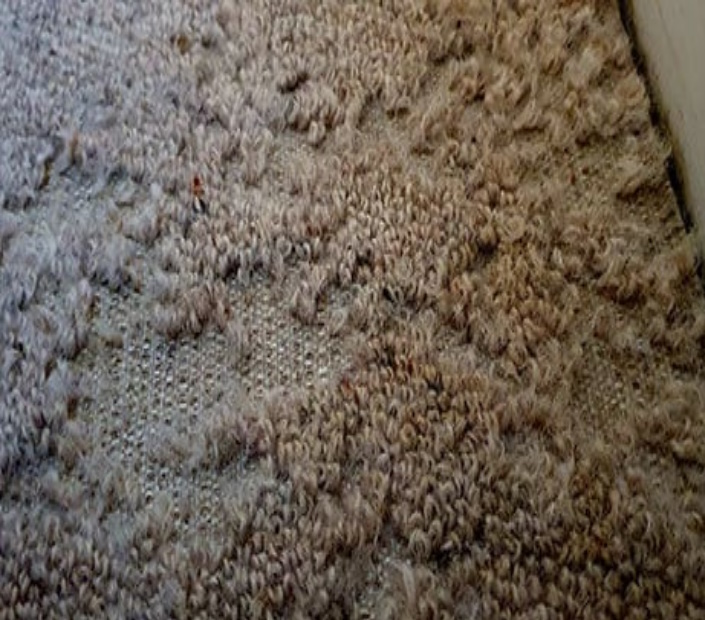
Skin Shedding:
In the carpet beetle larvae lifecycle cycle, they shed their skin several times. If you happen to come across such insect skin shedding pieces on your floor or below where you keep your clothes, it could mean that your home is potentially at risk for a significant carpet beetle infestation.
Beetle Droppings:
If you have a carpet infestation in your home, you can find some beetle droppings here and there. They look like tiny black or brown pellets that might be on the floor or near the places where you keep your clothes. It's pretty small, so it might take a second look to notice them the first time.
Do Carpet Beetles Bite?
No, carpet beetles do not bite, but if you are near them for periods, it is possible to develop rashes or get an allergic reaction. Although these beetles are often mistaken for bedbugs because of their appearance, especially adult carpet beetles, they are not the same as bed bugs and do not bite humans, dogs, or other animals.
But because of the rashes you might develop when you come in contact with a carpet beetle, many people tend to believe that these beetles are also like bedbugs that bite humans and animals.
However, you still have to watch out for these rashes caused by carpet beetles since they can develop into airborne respiratory tract infections or eye infections.
Do Carpet Beetles Fly?
Yes, carpet beetles can fly, so you must be careful if you spot them near your house or in your yard. It is easy for carpet beetles to enter your home through an open door or window since they can fly.
One of the reasons why they tend to thrive even in seemingly inadequate environments is because they can survive by feeding on dead insects, pollen, flowers, wasp nests, and even dead mice and rats.
Once these beetles enter your home, they can lay their eggs, which hatch anywhere between 10 days to a month. The larvae start feeding on your clothes, fabrics, rugs, and pet products, like your pet's destruction to your home in tiny but significant amounts.
What's Carpet Beetle Rash?
Although carpet beetles don't bite, close and prolonged contact with these bugs can irritate your skin. If unlucky, it could even develop into a more serious issue, such as a respiratory tract infection.
How you develop these rashes depends mainly on how long you were exposed to the larvae and how your skin or body reacts to this infection. Typically, you might notice a red-coloured rash in the affected area with small welts in clusters. You might also develop a joined rash more widespread than the small red welts.
You will likely develop a widespread rash if you wear clothes already infected with the carpet beetle larvae for a few hours. You'll also notice that these rashes are more common in toddlers and little children since they spend much time on the floor where the larvae live.
How To Get Rid of Carpet Beetles - Carpet Beetle Treatments
You won't be able to notice an infestation immediately because the eggs and the bugs are pretty small to see with the naked eye. However, there are a few signs, like holes in your clothes, rugs, or carpets in small but concentrated areas, which can tell you if you are dealing with a real problem with carpet beetles.
Adult carpet beetles lay about a hundred eggs which start hatching within 8-15 days. After they become larvae, they are at their most destructive stage, feeding on almost everything in your house.
Once you notice the damage, you can start treatments to kill carpet beetles.
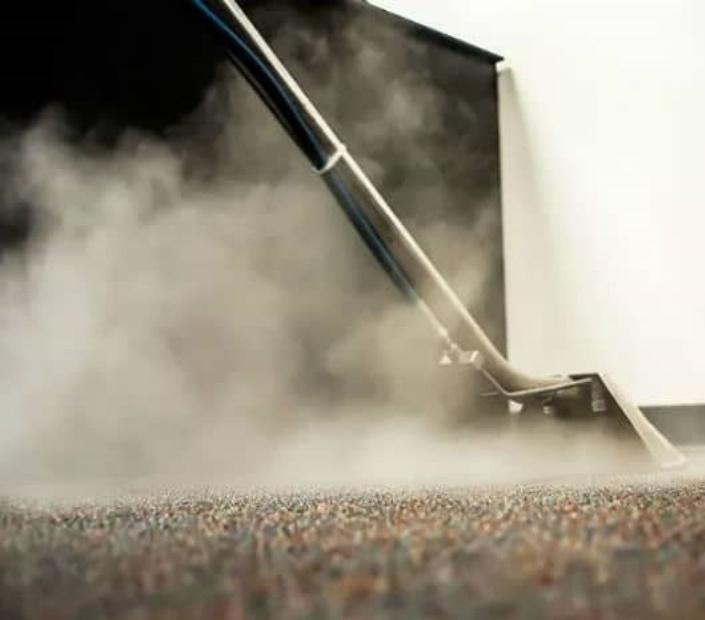
Professional Carpet Cleaning
Carpet cleaning can help destroy carpet beetles by removing the dirt, debris, and other organic matter that these pests feed on. Carpet beetles thrive in areas with high levels of organic matter, such as pet hair, skin cells, and food particles. Regular vacuuming and deep cleaning can help remove these food sources and make it more difficult for carpet beetles to survive.
In addition to removing food sources, carpet cleaning can also help physically remove carpet beetle larvae and eggs from the carpet fibres. Carpet beetle larvae are small and difficult to see, but they can cause significant damage to carpets and other fabrics. By thoroughly cleaning the carpet fibres, you could help eliminate these pests before they have a chance to cause further damage.
There are several different methods for carpet cleaning, including steam cleaning, dry cleaning, VLM carpet cleaning, and carpet shampooing. Each method has its own benefits and uses, but all can be effective at removing dirt, debris, and other organic matter from carpets. When choosing a carpet cleaning method, it's important to consider the type of carpet you have and the severity of the carpet beetle infestation.
Professional Pest Control
There are several different methods of pest control that can be used to destroy carpet beetles. One of the most common methods is the use of insecticides. Insecticides are chemicals that are specifically designed to kill pests like carpet beetles. They can be applied directly to carpets and other fabrics, as well as to cracks and crevices where carpet beetles may be hiding.
Another effective method of pest control for carpet beetles is fumigation. Fumigation involves sealing off a room or area and using chemicals to eliminate pests. This method can be particularly effective for large or severe infestations, as it can reach areas that may be difficult to access with other methods.
DIY Extermination: How to Kill Carpet Beetles and Carpet Beetle Larvae
Carpet beetles can be a nuisance in your home, but fear not because there are so many ways to get rid of them. Here are a few examples of getting rid of these pests.
Insecticide
The first and most obvious answer to getting rid of insects like the carpet beetle is to use an insecticide.
Before buying one:
1. Ensure that the insecticide contains ingredients like cyfluthrin, deltamethrin, or bifenthrin.
2. If you plan to spray the insecticide on your carpets and rugs, ensure it won't stain or damage them further.
3. Follow all safety instructions to avoid harming yourself or others.
Boric Acid
Sprinkling boric acid on your rugs and carpets can help eliminate any insect infestation since this substance is poisonous to their survival. Once you have spread the powder onto the surface, wait a few minutes before vacuuming it thoroughly.
If you don't want to use the powder as it comes, you may dilute it in a spray bottle and use it as a spray instead.
Diatomaceous Earth
This desiccant can kill larvae instantly by dehydrating the breeding ground. You can use it the same way as you would boric acid- by sprinkling it on the affected surface as a powder or diluting it in water and using it as a spray.
Be sure to buy only the food-grade variety of diatomaceous earth, which is not harmful to humans or pets, although we recommend you wear protective gear to keep yourself safe.
Fog
Flying insect foggers can be useful when removing adult flying carpet beetles entering your home. One of the worst things about these beetles is that they can always re-enter your house no matter how many times you get rid of them.
This is why it is a good idea to have a spray on hand for flying insects that will immediately get rid of the pests before they can settle and start breeding.
Vinegar
Any kind of white or apple cider vinegar can help eliminate pest infestations like these carpet beetles. You can spray the vinegar onto all surfaces you suspect might be an open invitation to carpet beetles, such as your clothes, rug, carpets, and furniture.
If you find races of eggs and larvae in your clothes or rugs, you can soak them in vinegar and give them a good wash to kill all the eggs.
Vacuuming
There's nothing a good vacuuming won't help get rid of, and that includes carpet beetles. Make sure you use all the different attachments to help you get into all the nooks and crevices where these bugs might be hiding.
How to Prevent Future Infestations
After you go through the thought process of ridding your house of these pests, you should follow a few steps to ensure that you don't allow another infestation to occur.
• Stop the adult beetles from flying into your home through open windows by hanging fly traps like sticky flypaper on your windows.
• Clean your upholstery regularly since these pests feed on soiled fabrics.
• Stick pheromone-type traps on your closets, air ducts, and window sills to prevent them from entering your home and laying eggs.
• Store all dry foods in airtight containers.
• Create a routine for carpet care and to dust, mop, sweep and clean your house every week so that you don't give the beetles a chance at breeding in an ideal environment.
